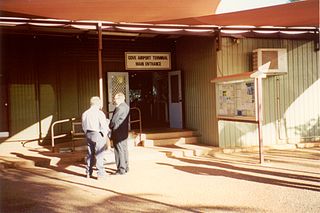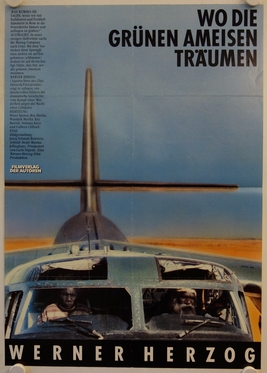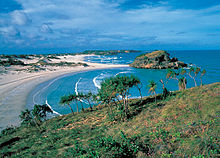
The didgeridoo ;, also spelt didjeridu, among other variants) is a wind instrument, played with vibrating lips to produce a continuous drone while using a special breathing technique called circular breathing. The didgeridoo was developed by Aboriginal peoples of northern Australia at least 1,000 years ago, and is now in use around the world, though still most strongly associated with Indigenous Australian music. In the Yolŋu languages of the indigenous people of northeast Arnhem Land the name for the instrument is the yiḏaki, or more recently by some, mandapul. In the Bininj Kunwok language of West Arnhem Land it is known as mako.

Arnhem Land is a historical region of the Northern Territory of Australia. It is located in the north-eastern corner of the territory and is around 500 km (310 mi) from the territorial capital, Darwin. In 1623, Dutch East India Company captain Willem Joosten van Colster sailed into the Gulf of Carpentaria and Cape Arnhem is named after his ship, the Arnhem, which itself was named after the city of Arnhem in the Netherlands.
Djalu Gurruwiwi, written Djalu, was a Yolngu musician, artist, and leader from Arnhem Land in the Northern Territory of Australia. He was globally recognised for his acquired skill as a player, maker, and spiritual keeper of the yiḏaki. As a respected artist with many of his works in several galleries, he aimed to spread his culture and traditions past his own community.

The Yolngu or Yolŋu are an aggregation of Aboriginal Australian people inhabiting north-eastern Arnhem Land in the Northern Territory of Australia. Yolngu means "person" in the Yolŋu languages. The terms Murngin, Wulamba, Yalnumata, Murrgin and Yulangor were formerly used by some anthropologists for the Yolngu.

Nhulunbuy is a town and locality in the Northern Territory of Australia. Founded on the Gove Peninsula in north-east Arnhem Land when a bauxite mine and deep water port were established in the late 1960s, the town's economy largely revolved around its alumina refinery until it closed in May 2014.
The Garma Festival of Traditional Cultures (Garma) is Australia's largest Indigenous cultural gathering, taking place over four days each August in northeast Arnhem Land, in the Northern Territory, Australia. Hosted by the Yothu Yindi Foundation, Garma is a celebration of the cultural traditions of the Yolngu people, and a major community gathering for the clans and families of the Arnhem Land region. The event showcases traditional miny'tji (art), ancient story-telling, manikay (song), and bunggul (dance). It is held at Gulkula, a significant Gumatj ceremonial site about 40 kilometres (25 mi) from the township of Nhulunbuy, attracts more than 2500 guests each year and is often sold out months in advance.

Yirrkala is a small community in East Arnhem Region, Northern Territory, Australia, 18 kilometres (11 mi) southeast of the large mining town of Nhulunbuy, on the Gove Peninsula in Arnhem Land.

Milirrpum v Nabalco Pty Ltd, also known as the Gove land rights case because its subject was land known as the Gove Peninsula in the Northern Territory, was the first litigation on native title in Australia, and the first significant legal case for Aboriginal land rights in Australia, decided on 27 April 1971.

Gove Airport is on the Gove Peninsula in the Northern Territory of Australia. It services the mining town of Nhulunbuy and several Aboriginal communities including Yirrkala. The airport is located 5.8 nautical miles south southeast of the Nhulunbuy town centre, on Melville Road. It is operated by the Nhulunbuy Corporation.
The Yirrkala bark petitions, sent by the Yolngu people, an Aboriginal Australian people of Arnhem Land in the Northern Territory, to the Australian Parliament in 1963, were the first traditional documents prepared by Indigenous Australians that were recognised by the Australian Parliament, and the first documentary recognition of Indigenous people in Australian law. The petitions asserted that the Yolngu people owned land over which the federal government had granted mining rights to a private company, Nabalco.

Where the Green Ants Dream is a 1984 English-language West German film directed and co-written by Werner Herzog, made in Australia. Based on a true story about Indigenous land rights in Australia, but slated as a mixture of fact and fiction, it only got a limited release in Australia, where it was not well received by critics; the film fared a bit better in Europe and North America.
Raymattja Marika, also known as Gunutjpitt Gunuwanga, was a Yolngu leader, scholar, educator, translator, linguist and cultural advocate for Aboriginal Australians. She was a Director of Reconciliation Australia and a member of the Australian Institute of Aboriginal and Torres Strait Islander Studies. She was also a director of the Yothu Yindi Foundation and a participant in the 2020 Summit, which was held in April 2008. Marika advocated understanding and reconciliation between Indigenous Australian and Western cultures.

Bauxite mining in Australia is an economically significant industry both for Australia and globally. The industry focuses on the mining of bauxite, the primary raw material for alumina and aluminium. Australia is the world's largest bauxite producer, producing almost a third of global bauxite.
Roy Dadaynga Marika was an Aboriginal Australian artist and Indigenous rights activist. He was a member of the Marika family, brother of Mawalan 1 Marika, Mathaman Marika, Milirrpum Marika and Dhunggala Marika.
The Dangu are an Aboriginal Australian people of Arnhem Land, in the Northern Territory, one of many Yolŋu peoples. They are, according to Norman Tindale, to be carefully distinguished from the Djaŋu.
Mithinarri Gurruwiwi (c.1929–1976) was an Aboriginal Australian painter of the Gälpu clan of the Yolngu people of north-eastern Arnhem Land in the Northern Territory of Australia. His first name is sometimes spelt Midinari, Mitinari, or Mithinari.
Mungurrawuy Yunupingu (c.1905–1979) was a prominent Aboriginal Australian artist and leader of the Gumatj clan of the Yolngu people of northeastern Arnhem Land in the Northern Territory of Australia. He was known for his bark paintings.
Ishmael Marika is a Yolngu musician, filmmaker, director and producer. His installations have been exhibited in many of Australia's most important museums, including the Museum of Contemporary Art in Sydney and the Art Gallery of South Australia in Adelaide. He is currently the Creative Director for the pre-eminent Indigenous media unit in Australia, the Mulka Project, based at Buku-Larrnggay Mulka Art Centre at Yirrkala in Northeast Arnhem Land. The Mulka Project seeks to preserve and disseminate the sacred languages and cultural practices of the Yolngu people by collecting and archiving photographs, audio and video.
Mathaman Marika (c.1920–1970) was an Aboriginal Australian artist and Indigenous rights activist. He was a member of the Rirratjingu clan of the Yolngu people of north-east Arnhem Land in the Northern Territory, and one of the well-known Marika family, brother of Mawalan 1 Marika, Milirrpum Marika, Roy Dadaynga Marika, and Dhunggala Marika. Mathaman was second oldest after Mawalan.
Gurruwiwi is a surname of the Yolngu, an Aboriginal Australian people of Arnhem Land, Northern Territory of Australia, and family members have close connections with the Yunupingu and Marika families.












